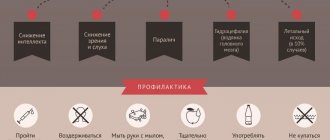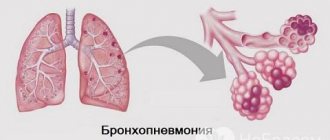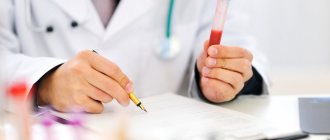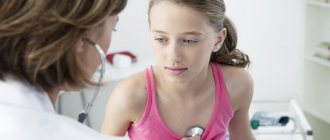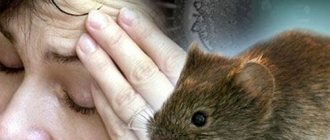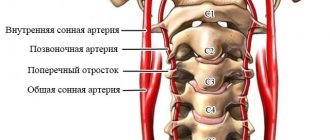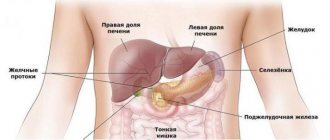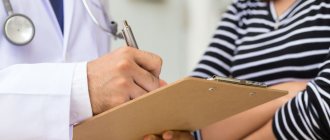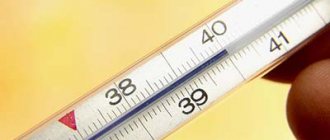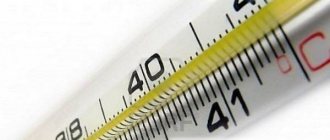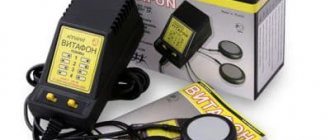Pain during urination and frequent urge, small volume of urine excreted, itching, inflammation, discomfort during sexual intercourse - these are signs of the presence of Escherichia coli in the urine. Escherichia coli is an opportunistic intestinal anaerobic bacterium that strengthens the human immune system and stimulates digestive processes.
Pain during urination and inflammation may indicate the presence of Escherichia coli in the body
Methods of infection
E. coli outbreaks are seasonal. Epidemics occur more often in the summer months. Main routes of infection:
- oral-fecal – after contact with water and soil contaminated with feces, as well as with vegetables that grew on it;
- contact-household - from a sick person through common objects (this method is less common than the first);
- from inflamed organs of the genitourinary system;
- transmission of escherichia coli from mother to child during childbirth.
The last method of transmission is the most dangerous, with a large number of complications. A newborn's immune system is weakened, so the body is unable to fight E. Coli. The bacterium multiplies rapidly and attacks the brain, causing meningitis.
The incubation period is 3-8 days.
In newborns, Escherichia coli is hemolytic and lactose-negative. An increase in the level of the first variety should cause concern among doctors. A lactose-negative bacillus must be present in the intestines, but its norm is 10 5. Exceeding normal levels leads to the appearance of undigested food particles in the stool, as well as to alternating constipation and diarrhea.
The main source of E. coli infection is cattle. Along with the animal's feces, bacteria are released that enter the soil and water bodies. Meat that has undergone insufficient heat treatment, as well as unpasteurized milk, is a source of infection.
Predisposing factors for infection are failure to comply with personal hygiene rules, a decrease in the body's protective properties, an unfavorable epidemiological situation, and visiting countries with high levels of water and soil pollution.
All coliform bacteria (coliforms) can be divided into opportunistic and pathogenic. There are more than 100 strains of the latter. They are the ones who cause intestinal infections. Among the main types of E. coli are:
- Enteroinvasive. The symptoms of infection are similar to dysentery.
- Enteropathogenic. More often they colonize the small intestine of infants.
- Enterotoxigenic. They cause stomach diseases, the symptoms of which disappear within 3-5 days without drug treatment.
- Enterohemorrhagic. Accompanied by the development of colitis and uremic syndrome, leading to a rapid deterioration in health.
All pathogenic E. coli can cause infectious diseases (escherichiosis). All E. Coli can survive for a long time in the external environment - in feces, water and soil. The bacterium is killed by certain chemical compounds, as well as exposure to temperatures above 70˚C.
Possible complications
In adults, the infection can affect the urinary system, developing cystitis and pyelonephritis. In women, adnexitis is diagnosed, and in men, prostatitis.
When the disease develops in older people, the following complications are possible:
- thrombosis;
- acute heart failure;
- sepsis;
- hypovolemic, infectious-toxic shock.
In children, hemolytic-uremic syndrome may occur . Due to the low resistance of the body, the walls of the capillaries are destroyed and blood circulation is disrupted.
The following negative changes are noted:
- rapid rise in temperature;
- the presence of blood in the stool;
- pale skin due to hemorrhages;
- thrombosis, vascular necrosis;
- signs of kidney failure.
If measures are not taken promptly, there is a high risk of death.
Symptoms
General deterioration of health and digestive disorders are the main symptoms of E. coli. Intestinal infection can occur as enterocolitis, food poisoning, dysentery or cholera-like infection, hemorrhagic colitis. Symptoms depend on the type of microorganism, so each class needs to be studied in more detail.
Enteropathogenic symptoms of Escherichia coli
This pathogen causes nausea, vomiting, stomach pain, severe diarrhea and high body temperature. The stool is copious and watery. This form of escherichiosis is most often diagnosed in children under one year of age.
Enterotoxigenic symptoms of Escherichia coli
Escherichiosis is most often caused by dirty hands, as well as unwashed vegetables and fruits. E. coli is firmly attached to the intestinal mucosa, so the symptoms are pronounced.
Signs:
- copious watery stools;
- paroxysmal abdominal pain;
- nausea and vomiting;
- weakness;
- muscle and joint pain;
- increase in body temperature.
Manifestations of this group of bacteria, Escherichia coli, are often called “traveler's diarrhea.”
Enterohemorrhagic symptoms of Escherichia coli
Bacteria of this group, E. coli, lead to the most severe consequences. Hemolytic E. Coli causes acute hemolytic anemia as blood cells are destroyed. This can lead to the death of the patient, so it is important to recognize the infection in time.
Symptoms:
- bloody diarrhea;
- nausea, vomiting;
- lack of appetite;
- weakness;
- headache;
- fever, high body temperature;
- stomach ache.
In children, bacteria of this group of E. coli have characteristics - bloating, liquid feces with mucus and particles of undigested food, regurgitation, vomiting, increased body temperature, tearfulness and restlessness.
This type of escherichia coli occurs in children, the elderly, and women after childbirth.
Symptoms always appear suddenly and acutely. In addition to the destruction of blood cells, damage occurs to the renal tubules and glomeruli. Ischemia of the vessels of the renal glomeruli develops, and then acute renal failure. As a result of toxic effects, hemolytic jaundice appears, the skin acquires a lemon-yellow tint.
Enteroinvasive symptoms of E. coli
This group of bacteria, Escherichia coli, is more common in children, causing the following symptoms:
- loose stool mixed with blood;
- lower abdominal pain;
- weakness;
- refusal to eat;
- headache;
- increase in body temperature.
Diagnostics
It is possible to detect an increased content of Escherichia coli in a patient’s urine and identify the degree of microbiological disorders using the following diagnostic techniques:
- Questioning the patient, identifying symptoms.
- Examination of the urinary organs.
- Collection of general and biochemical urine tests.
- Taking cultures for microflora.
The last method is the most significant. If the flora culture reveals the presence of Escherichia bacteria over 105 CFU, the patient is prescribed appropriate treatment, regardless of the absence or presence of severe symptoms.
Features of urine collection
When testing urine for E. coli, a false positive result often occurs. In most cases, this is due to improper collection of material for research:
Taking urine for analysis is carried out as follows:
- To take the test, buy a special sterile jar at the pharmacy.
- The analysis is taken in the morning, immediately after waking up.
- Before the procedure, the patient thoroughly washes his hands with neutral soap.
- Women cover the vaginal opening with sterile cotton wool or a tampon.
- At least 70 ml of urine is taken into the container. The first and last streams of urine are passed.
- The material is sent to the laboratory 1-2 hours after collection.
Correctly collect urine for analysis to obtain a reliable research result
The day before the test, you should not consume coloring foods, diuretics, or perform strenuous physical exercise.
The best option would be to get tested in a medical office using a catheter.
Escherichia coli and the genitourinary system
E. coli, entering the organs of the urinary or reproductive system, leads to diseases of these organs. Common diseases caused by E. Coli:
- cystitis;
- pyelonephritis;
- urethritis, prostatitis, epididymitis and orchitis in men;
- adnexitis, vulvovaginitis, endometritis, colpitis in women;
- peritonitis.
Escherichia coli penetrates from the rectum into the urethra and bladder in an ascending manner. There are suggestions that the bacillus is transmitted sexually from an infected partner.
Infectious diseases caused by E. coli are difficult to treat. The bacterium weakens local immunity, which makes there a high probability of infection with gonococci, staphylococci and other dangerous microorganisms. Chlamydia or gonorrhea may develop.
Along with genitourinary diseases, complications from the digestive tract are possible, for example, pyelonephritis is often accompanied by acute pancreatitis.
E. coli normal
Escherichia coli is a microscopic bacterium. Its characteristics:
- gram-negative microorganism;
- size only 2x0.6 microns;
- sustainable in the environment;
- optimal pH 7.2-7.4;
- suitable temperature is 37˚C.
Non-pathogenic strains are part of the microflora of a healthy person. Normally, their number varies from 10 6 to 10 8 CFU/g. They populate the intestines in the first days of a baby’s birth.
If the normal number of microorganisms is exceeded, then E. Coli. have a toxic effect, so treatment is necessary.
Grandma's recipes
Traditional medicine will perfectly complement the drug treatment of hemolyzing Escherichia coli in adults:
- Jerusalem artichoke (300 g) is peeled, cut into cubes and placed in boiling milk diluted with water (500 ml). When the Jerusalem artichoke softens, take it out and add flour (20 g) and butter (40 g) to the milk. Cook until thickened. Next, pour this sauce over Jerusalem artichoke and add greens.
- Goose cinquefoil (20 g) is brewed with hot water (250 ml) and, after holding over low heat for a quarter of a minute, left overnight. You need to drink this medicine 3 times a day, 80 ml.
- The succession herb (10 g) is poured with cooled boiled water (250 ml) and placed in a water bath for 15 minutes. Take 20 ml of broth in the morning, at lunchtime and in the evening.
- Mix medicinal clover, coltsfoot and centaury in equal parts. Pour boiling water (250 ml) into the herb mixture (20 g). Leave for a quarter of a minute. Drink 20-50 ml once a day.
- It is also possible to eat 0.5 g of mumiyo three times a day for a month before eating.
Folk remedies (after discovering hemolyzing E. coli in the stool of an adult) will help restore the microflora of the intestinal tract and eliminate the negative effects of pathogens.
Analyzes
The basis of the examination for diagnosis is laboratory diagnosis of escherichiosis. It assumes:
- blood analysis;
- urine and stool analysis;
- coprogram, feces for dysbacteriosis;
- vaginal and urethral smear;
- analysis of vomit;
- urine test for acetone.
As a result of the data obtained during the examination, one can judge the state of the intestinal microflora, the severity of intoxication of the body, as well as determine the type and class of bacteria, their resistance to antibiotics.
If Escherichia coli is detected in the blood, this indicates a serious condition that can be fatal. Such patients are subject to urgent hospitalization.
Determining an accurate diagnosis
At home, it is impossible to reliably determine the presence and specific type of E. coli. To make an accurate diagnosis, laboratory tests will be required . There are several methods:
- Bacterioscopic. Samples of intestinal contents, a vaginal smear, and urine and blood tests are taken from the patient. All selected materials are studied under a microscope.
- Bacteriological. The biological material taken from the patient is transferred to a special favorable environment. If E. coli is present, then after some time it begins to actively multiply. In some cases, an antibiogram may be subsequently performed. It is used to determine the sensitivity of bacteria to various types of antibacterial drugs.
- If the infection is localized in the intestines, then a study is necessary to determine the degree of dysbiosis.
Only after pathogenic E. coli is detected and its type is determined, a specialist can make an accurate diagnosis and develop a method for dealing with the problem.
Treatment
It is unacceptable to treat E. coli on your own. The symptoms of escherichiosis are similar to other infectious diseases, so it is impossible to select adequate therapy at home. All medications are prescribed only after the results of bacterial culture. Treatment of E. coli is possible only with the help of antibacterial drugs.
Basic medical measures for escherichia coli:
- hospitalization (for young children and patients with dehydration);
- bed rest;
- drug therapy (antibiotics, probiotics, detoxification agents, rehydration);
- dietary nutrition (diet No. 4 for intestinal damage and table No. 7 for diseases of the kidneys and genitourinary system).
Drug therapy is primarily aimed at preventing dehydration of the body, maintaining vital functions and preventing complications from the gastrointestinal tract and genitourinary system.
Treatment of escherichiosis with medications looks like this:
- cephalosporin and fluoroquinolone antibiotics - Levofloxacin, Moxifloxacin, Cefaprim, Cefazolin, Cefepime;
- bacteriophages (preparations containing viruses that kill E. coli) – Liquid coli;
- probiotics (required for dysbacteriosis) – Hilak forte, Linex, Acipol, Enterol;
- enterosorbents (to relieve symptoms of intoxication) – Smecta, Enterosgel, Polysorb;
- rehydration solutions (for the prevention of dehydration caused by vomiting and diarrhea) – Trisol, Regidron;
- antipyretic drugs (at temperatures above 38 ° C) - Paracetamol, Panadol, Ibuprofen.
Bacteriophages have a pronounced therapeutic effect. They kill the pathogen escherichia coli, so recovery occurs faster than with antibacterial therapy.
If E. coli leads to the development of complications in the form of meningitis, pyelonephritis, cholecystitis or sepsis, then antibiotics of the cephalosporin group, for example, Cefuroxime, are necessarily used.
Severe dehydration, which is accompanied by electrolyte disturbances, is treated with infusion solutions.
Antibacterial treatment lasts 5-7 days. After recovery, the patient should take probiotics, for example, Bifidumbacterin, for 2-3 weeks, and also follow a diet.
Special diet
In addition, a special diet is prescribed, in which it is allowed to consume certain types of foods and the required amount of liquid.
If the gastrointestinal tract is affected, diet No. 4 is prescribed. It allows you to drink a lot of water, up to 3-4 liters per day, food should contain a sufficient amount of proteins, but the amount of carbohydrates and fats is greatly reduced. All food should be pureed to prevent intestinal injury and increase the absorption of nutrients into the blood.
Such a diet is necessary to restore the intestinal mucosa, reduce irritation and swelling, and also to reduce the processes of fermentation and gas formation.
If the urinary system is damaged, table number 7 is prescribed. The work of such a diet is aimed at restoring normal fluid levels and water-salt metabolism.
The diet is specific, because salt is completely excluded from the diet and the amount of water per day is limited to 1 liter. Also, the amount of protein necessarily decreases, which, under the influence of substances secreted by E. coli, turns into a toxin and only worsens the patient’s condition.
A detailed description of the products and a sample menu must be given to the patient at the medical institution and instructed upon discharge home, so that the patient can independently continue to eat the necessary products.
Prevention
All preventive measures for Escherichia coli boil down to the following recommendations:
- observe the rules of personal hygiene;
- wash vegetables and fruits thoroughly;
- follow the rules of heat treatment of meat;
- do not drink raw milk;
- purchase meat and dairy products only from trusted sellers with a quality certificate for the product;
- strengthen immunity;
- regularly carry out wet cleaning in the house.
At the first symptoms of E. coli, you should immediately visit a doctor. After recovery, you need to see a doctor on days 6-8 to rule out a relapse.
Intestinal infection is common among adults and children. It is not only accompanied by severe symptoms, but can also lead to severe dehydration, disruption of important body functions, and death of the patient. It is important to follow preventive measures and treat E. coli at the first manifestations.
Intestinal infections are very common among children. And this is not surprising, because babies love to experience the world by taste, and as soon as they acquire the ability to grasp various objects with their hands, the first thing they do is begin to drag these objects into their mouths. The famous children's doctor Evgeniy Komarovsky talks about how to prevent unpleasant consequences, how to treat a child with an intestinal infection, and what you should know about it in general.
Even more interesting:
Causes of sores on the labia
Yarina with folic acid
Reasons for entering the body
E. coli exists and reproduces under ambient temperatures of 37 degrees. It feeds in the intestines with minerals and amino acid breakdown products. Retains its viability when entering water bodies, soil and products.
The genus Escherichia belongs to the Enterobacteriaceae family. The largest group of varieties of microorganisms is beneficial to the body. Some strains are pathogenic in nature - a number of severe food poisoning and genitourinary infections appear. In severe immunodeficiency conditions, when E. coli has spread throughout the body, it can lead to the development of meningitis and sepsis.
The main reason for contracting intestinal infections is non-compliance with hygiene standards.
There are 2 ways by which the infection is transmitted:
- Water. The infection enters the body through drinking unboiled or poor quality water.
- Nutritional. It is characterized by ingestion of contaminated food. With this method of infection, food poisoning often occurs in a person who has used contaminated products for cooking. For the human body, such food is poison.
Orally, Escherichia coli enters the intestinal tract from:
- dirt on hands;
- dirt on vegetables and fruits;
- insufficiently thermally processed meat;
- contaminated raw water;
- raw milk (according to statistics, this method of transmission is the most common).
Contact-household transmission is rare. More often it can be observed during an outbreak of eschechiriasis in a separate room (maternity hospital, hospital, school, etc.). One of the most dangerous ways to become infected with E. coli is through transmission of the infection during childbirth from mother to child.
What it is
Intestinal infections are not a separate ailment, but a whole large group of diseases that share the same symptoms - diarrhea, vomiting, fever. Bacteria and viruses can cause diseases. The disease does not develop immediately, but only 10-45 hours after a pathogenic microorganism enters the body . The most dangerous are salmonellosis, dysentery, staphylococcus, and cholera. Among viral infections, the leaders in frequency of occurrence are enterovirus and rotavirus infections.
Sometimes a disease caused by one or another external pathogen is complicated by the fact that opportunistic bacteria that live in the intestines, for example, hemolyzing E. coli, begin to “rebel.” While the child is healthy, it does not manifest itself, but the organism weakened by the infection becomes not a home for it, but a battlefield, and the microorganism begins to parasitize, worsening the child’s condition.
What types are there?
Symptoms of hemolyzing E. coli in adults depend on the type of bacterium.
For example, Escherich's bacillus has approximately 100 strains. Escherichia coli bacteria are considered an essential component of the beneficial microflora of the gastrointestinal tract. They take part in the synthesis of vitamin K and B and the digestion process. However, certain strains are pathogenic microorganisms. The most common of these is sickle cell or hemolyzing Escherichia coli.
Lactose-negative Escherichia coli is a symbolic pathogenic microorganism. She is able to live in the intestinal tract without giving herself away.
Hemolytic E. coli, present in the body of infants, can cause death if treatment is not started in time.
Doctor Komarovsky about the problem
There is nothing to be ashamed of here, says Evgeny Komarovsky. Even the cleanest mother, even if she chooses only the best products for her child, the baby may well get an intestinal infection. According to statistics from the World Health Organization, a huge number of children fall ill with these diseases every day on the planet. More than 2 million children under the age of 5 die every year from such infections. But among the official statistics there is also a comforting figure - 90% of all cases of intestinal infections among children can be quickly and effectively cured without the use of any medications on their own at home.
Most parents are well aware of the symptoms: diarrhea (loose stools), nausea, vomiting, complaints of pain in the abdomen. It is precisely the localization of pain that Evgeniy Olegovich recommends paying attention to first of all.
If bacteria or viruses have infected the stomach, then the child has gastritis. If inflammation develops in the small intestine, this is enteritis, and if the large intestine is affected, then we can talk about colitis. But here, too, not everything is simple, and often children have mixed diagnoses - enterocolitis, gastroenteritis.
The meaning of E. coli
Escherichia coli is a small bacterium that has an oblong shape with rounded corners. The normal levels of these opportunistic microbes in the human body are 10*8 CFU. The child’s digestive tract is populated by these microorganisms almost immediately after birth, so if their number does not exceed the norm, then they do not cause pathological conditions. A particularly active increase in the number of bacteria in the body is observed when there is a lack of oxygen, which leads to the development of inflammatory processes. Today, experts identify more than a hundred harmful bacterial agents, which are divided into the following classes:
- enteroinvasive;
- enteropathogenic;
- enterotoxigenic;
- enterohemorrhagic.
E. coli enters the body through dirty food or poor-quality water. Among food, the main threat is:
This type of bacteria also actively multiplies if the rules of personal hygiene are not observed (for example, by not washing hands thoroughly).
Preventive actions
To prevent E. coli infection, you need to follow simple precautions. Prevention includes:
- Compliance with all principles of personal hygiene. Try to wash your hands as often as possible , especially after being in public places.
- Adults who are sexually active need to remember the rules of intimate hygiene.
- Don't eat unwashed fruits and vegetables.
- When preparing dishes, make sure that the food is well cooked. Do not cut meat and other foods on the same cutting board.
- Be sure to store any leftover food in the refrigerator.
- Do not drink water from taps or unknown sources. You can safely drink only boiled water .
By following simple rules, you can protect yourself from E. coli. But if infection does occur, you need to take action as quickly as possible.
Symptoms of E. coli development in children
Intestinal infection occurs in children mainly in the warm season, because it is the child’s fragile body that is most vulnerable to pathogenic bacteria in the summer. When infected, symptoms of food poisoning in children begin to manifest themselves acutely within a day.
Among the main symptoms of E. coli infection are the following pathological conditions:
- nausea and vomiting (lead to dehydration);
- spasmodic pain in the intestines;
- lack of appetite;
- diarrhea;
- intoxication of the body;
- increase in body temperature.
Intestinal damage in children manifests itself quite quickly, so at the first signs of infection you should contact a specialist. If the disease is not diagnosed in time and appropriate measures are not taken to treat it, the blood supply to the intestinal walls is disrupted with their subsequent destruction.
Varieties
A common pathogenic bacterium is hemolytic Escherichia coli. The consequences of bacteria range from serious poisoning to the development of dysbacteriosis and colibacillosis. Often, sticks become the culprits of diseases - inflammation of the urinary canal, testicles, vagina, lungs; purulent infection of the brain, blood.
Lactose-negative Escherich bacillus is an opportunistic microorganism. It is not detected in the intestines for a long time. As the concentration increases, the disease manifests itself.
Hemolytic bacillus in an infant is the cause of death in the absence of timely assistance.
Diseases caused by Escherichia coli
E. coli can cause the development of a number of diseases, which are usually called by the general term - escherichiosis. Depending on the location of the outbreak and the type of microorganisms that have affected the child’s body, diseases can manifest themselves in several forms.
An increase in the number of enteropathogenic bacteria is manifested by disturbances in the functioning of the digestive system. In this case, the child usually has severe stomach pain and refuses to eat. The pathology is observed in children attending kindergarten, but infection can also occur in a hospital or maternity hospital.
With an excess of enterotoxigenic microorganisms, E. coli causes symptoms similar to cholera. Infection of the body occurs mainly due to the consumption of contaminated food or water. With advanced infection, other diseases may develop - otitis media, meningitis, sepsis, requiring hospital treatment.
Infection with enteroinvasive bacteria causes symptoms similar to dysentery. At an advanced stage of the disease, damage to the genitourinary system and biliary tract may occur. Disruption of enterohemorrhagic microflora in children is dangerous due to the development of serious complications, manifested by anemia, a decrease in the number of platelets in the blood and renal failure. The bacterium in a child can become the causative agent of quite dangerous pathologies that affect various systems of the body, and the lack of treatment leads to deterioration of health.
Bacteriological research. The biological material taken from the patient is placed in a nutrient medium. If pathogenic microorganisms are present, their numbers increase sharply.
Only after detecting and determining the type of bacillus in a child, which is confirmed by the corresponding results of laboratory tests, a specialist makes an accurate diagnosis and prescribes treatment.
How the infection is transmitted, the mechanism of its development
Hemolyzing Escherichia coli in children develops as a pathogenic microorganism in the event of errors in nutrition - feeding with low-quality infant formula, improper storage of dairy products, contaminated breast milk, lactose intolerance. Also, in children, the infection develops due to the immaturity of the digestive system, with decreased immunity.
Escherichia, entering the digestive tract, leads to an imbalance of microflora. Escherichia coli causes dysbacteriosis in newborns and babies in the first months of life. Beneficial bacteria are not yet sufficiently populated in the intestines, and the pathogenic microbe leads to a decrease in their number.
Characteristic symptoms in infants:
- The child develops intestinal colic and paroxysmal pain in the tummy, which intensifies after feeding.
- Appetite disappears, the child refuses to eat.
- The inflammatory process in the stomach and intestines prevents the normal passage of food. Babies spit up more frequently.
- The smaller the child, the more often he has impaired absorption of nutrients in the intestines.
- Diarrhea - the stool becomes liquid, foamy, with mucus impurities, the smell is putrid, sour.
- Children in the first year of life experience weight loss.
- The kids don’t sleep well, they’re capricious, and they cry often.
A dangerous symptom for a child’s body is dehydration. Its signs:
- dry skin and mucous membranes;
- formation of skin folds that do not smooth out;
- rare urination (less than every 4 hours);
- crying without tears.
Treatment of E. coli in children
Treatment of intestinal infections should be carried out under the supervision of a specialist. The doctor prescribes antibacterial drugs of the penicillin and macrolide groups, sorbents and bacteriophages. The duration of treatment is no more than 5 days. It is important to follow dietary rules in the treatment of E. coli. It is recommended to include slimy soups, cereals, boiled vegetables and steamed meat or fish in the patient’s menu. It is worth remembering that in case of pathology of the digestive system, the consumption of smoked meats, canned products and spices is contraindicated.
